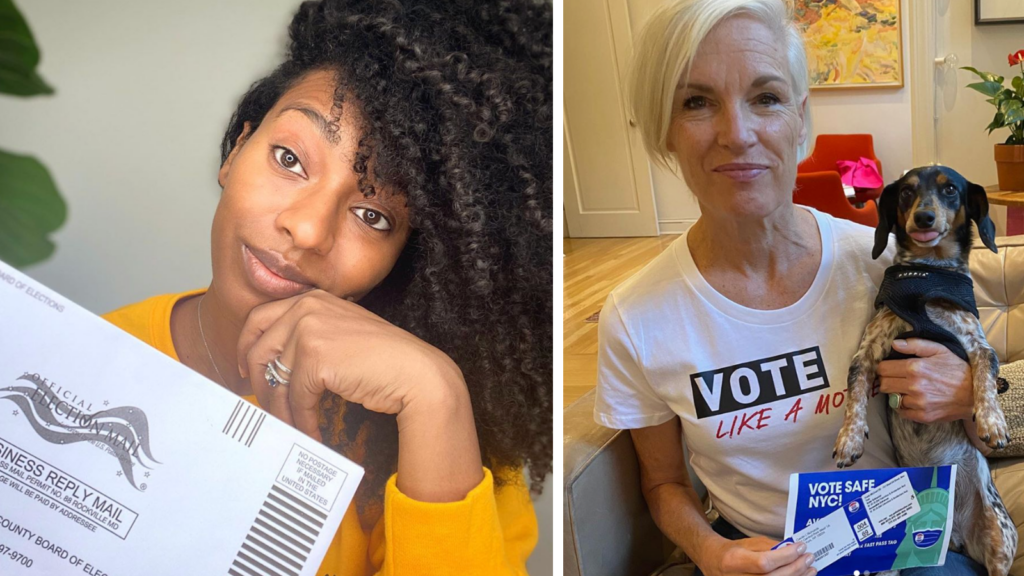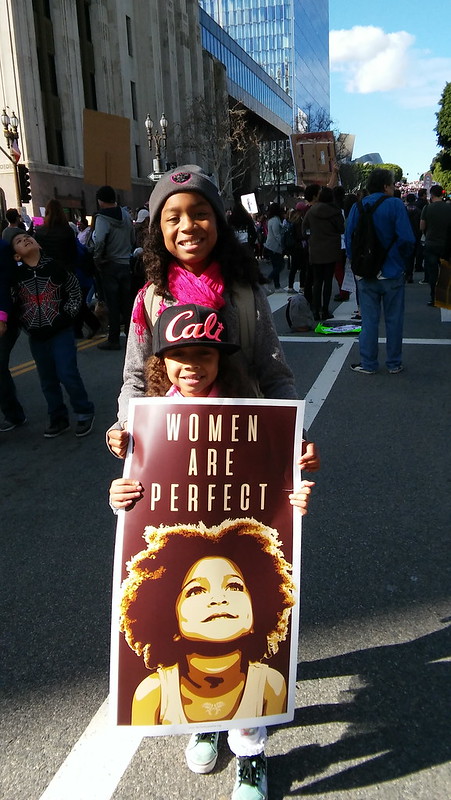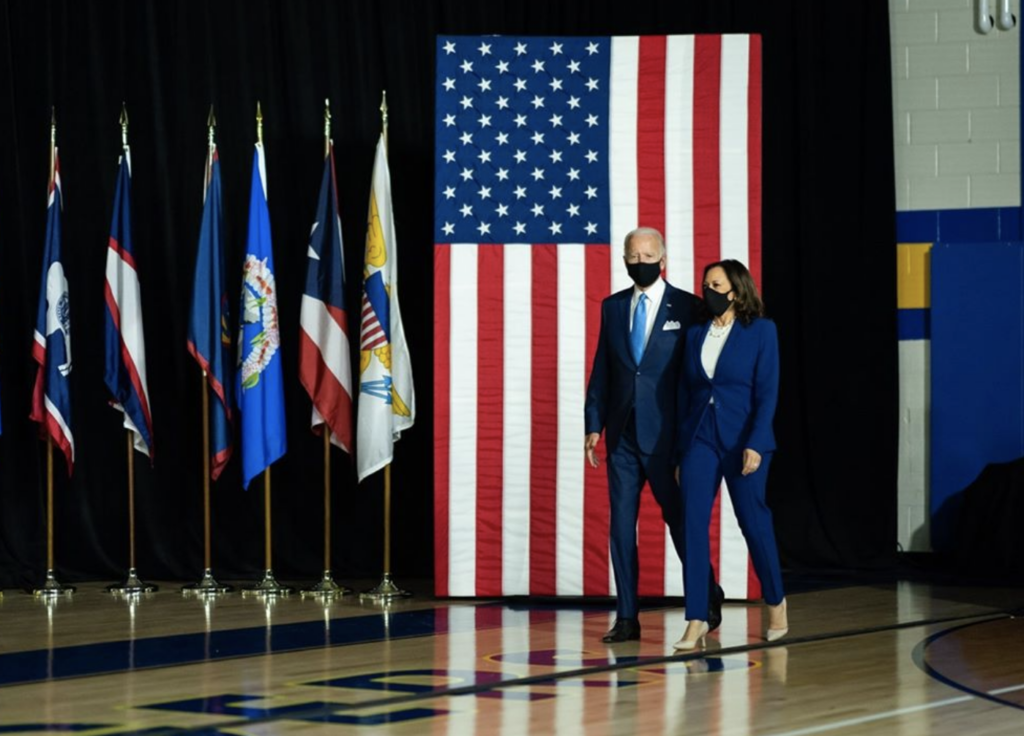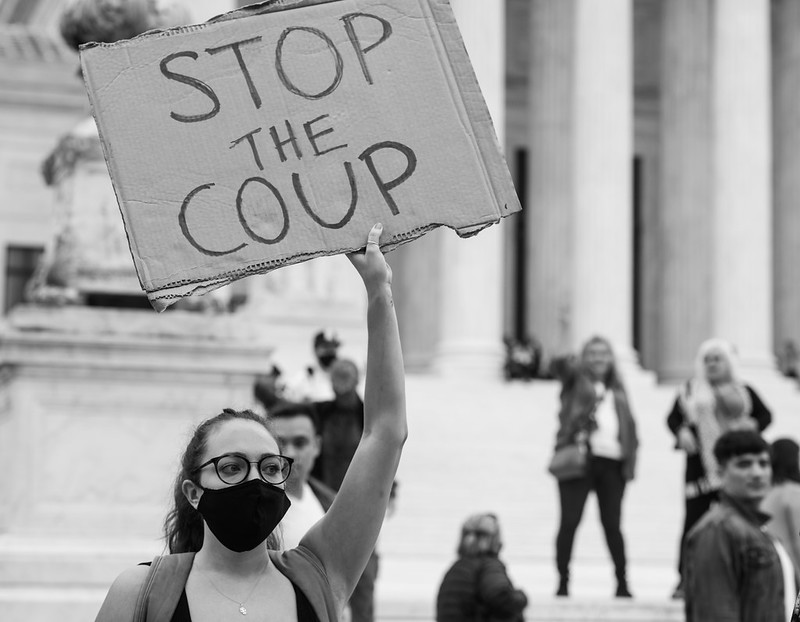“The question of electability will now be answered by women. Women are in the driver’s seat.”

The gender gap measures the difference in men and women’s votes for the leading candidate. This year, the gender gap is wider than it’s ever been—a large reason for Biden’s lead nationally and in the battleground states.
On top of that, the proportion of voters who self-identify as feminists is larger than at any time in the past—meaning this year more than any other, the “feminist factor” (first identified and defined by Ms. in the 2012 election) will be a driving force on the outcome of the 2020 elections.
But what do these women voters want? And what’s different about the 2020 election, compared to those in the past?
To answer these questions and further discuss women’s political power, Ms. tapped one of the largest women’s political organizations in the country: Supermajority, aptly named since women represent more than one-half of this country, and a much larger percentage of voters.
Ms. editor Roxy Szal spoke to Cecile Richards, Supermajority’s CEO and co-founder, and Juanita Tolliver, Supermajority’s political director, who broke down how to organize a political movement in the middle of a pandemic; what’s driving (and not driving) women and feminist voters; the impact of the Amy Coney Barrett confirmation on the election; and what to watch for on Election Day.

Editor’s note: This interview has been edited for clarity and length.
Roxy Szal: If you could just tell me a little bit about Supermajority—what motivated you to start a new organization?
Cecile Richards: I had been working for Planned Parenthood for more than a dozen years, and this was post 2016 election.
Everywhere I went, a new women’s group had popped up. And it was often started out of the Women’s March. People had gotten together and said, What more can we do? And that really led me, along with my friend Ai-jen Poo, director of the National Domestic Workers Alliance, Alicia Garza, and others to say: We need to build a political home for women.
So we did travel around the country listening to women, convening women across race and issues and geography, and really, there was a very consistent theme. Women wanted to be in community with other women. They wanted to know what other women were doing. How were they being successful? How were they making progress?
And then, of course, they wanted to take action, and so we launched Supermajority about a year and a half ago now. It started as the idea of building a multiracial, intergenerational, multi-issue home for women’s activism. We did national trainings in various parts of the country. We did a bus tour where we actually brought presidential candidates into conversations with women. We did presidential forums to put the issues that women cared about before the candidates—and then, of course, once COVID hit, like every other organization, we pretty much moved to be digital first. Now, of course, we’re in this last sprint to help every single woman we can cast her ballot and make sure it’s counted.
Szal: Since COVID, lots of groups have had to rethink their election and organizing strategies. What did you all have to change and what could you all keep the same?
Richards: One of the hard things was we had to get off the road. I’m an organizer at heart, and a lot of the folks that started Supermajority are used to in-person convenings, so we had to immediately shift out of that. The good news is we’ve spent a year building a base, and we had built some relationships not only with individual women, but with organizations on the ground. So we were able to kind of carry those forward.
The other piece of this was, of course, like many organizations, we shut down our offices. So everyone began to work virtually, and the good news is we had people already spread around the country, so that wasn’t as big a shift, but of course, like everyone, we miss each other.
I think the other piece of it, though, is we had always believed in the ability to expand the use of digital tools, specifically for women, and had already been on that road. And one of the things that we felt was most important was to create a digital home, if you will, where any woman in the country could find out if she was registered to vote, where she could find out where her local polling location was, and also understand the rules as they were changing, because, as you know, literally, they’re changing day by day.
We worked, really, throughout the spring and summer with various iterations of what became Supermajority home, which is now a source of all that information for voters as well about how women can volunteer and reach out to other women, giving them the basic tools.
Juanita Tolliver: Even before COVID, we were really leaning into a digital approach that leveraged text programs, phone programs, SMS programs, and creating online voter information portals where women could easily access an individualized experience to make sure they had every single thing that they needed to vote.
I think also these focus groups showed us that for women who were irregular voters, and high opportunity voters, knowing the rules for how to vote in this moment of COVID where the rules are changing in real-time was a big fear and a big concern, and so we really doubled down on our decision to create that online portal where people could have that individualized experience to find their voting information, get up-to-date, accurate updates as well. … We really wanted to leverage our massive reach through our collaborations with Pantsuit Nation, through our own membership, which has grown immensely since I’ve been on the team, and then again through our target get out the vote efforts with young women and women of color in those three target spaces of Michigan, Pennsylvania and Arizona.

Szal: ‘Tis the season of polls—and the gender gap is deeper and wider than ever before, since women voters have been strongly for Biden before and after the conventions and now in these final days.
What insights can you share about women voters in 2020 that may be different from 2016 or in some past elections?
Tolliver: The biggest insight that comes to mind about why Biden has maintained those numbers is because women recognize that Trump has failed them in his leadership in every possible way. They are looking for a leader who would provide immediate solutions for a lot of the issues women are experiencing in real-time, whether that’s related to this ongoing pandemic, which we know Trump and his administration have now said they’re not going to be able to contain and just don’t let it run your lives, as though women—especially women of color who have been disproportionately impacted by infection rates, death rates, unemployment rates—can actually live like that.
And so I think there’s just a desire for a leader who is going to step up to the plate with real plans of action to address their current needs in real-time, because folks are just living through a trifecta of issues, whether that’s COVID-related, whether that’s economic-related, and especially for women of color, racial injustice and the ongoing fight for Black lives.
Richards: Well, 2016, obviously, was an extremely disappointing election year, and the one theme that I think was so painful is that a plurality of white women voted in favor of Donald Trump. … It means we can’t rely on women of color and Black women, in particular, to save us all, and we have to put the case out there to white women that they’re needed and that we’ve got to build something. So what you saw, of course, in 2018 was a big shift where women, in fact, dominated everything about the midterms as candidates, as voters, as activists, even as donors.
There’s an interesting statistic that $100 million more were contributed by women in the 2018 midterms than in 2016 when Hillary Clinton was running for president. So I think there was a real wakeup call in 2016 that was begun to be answered in 2018 and now has just carried forward in 2020.
The meta story to me is women are completely driving both the resistance to Donald Trump and this administration, the fight that’s on every single issue, and they are dominating this election cycle as voters. To me, the interesting thing, of course, is women stand poised not to just change things in 2020, but frankly, to redefine politics in this country for the rest of the century.
I love something Errin Haines from The 19th said the other day, which I thought was just a perfect way of recasting this, which is: The question of electability will now be answered by who women will elect, because women are in the driver’s seat.
It’s not about suburban women. It’s not about stay-at-home moms. It’s about women. Period. End of story.
In the lead-up to this election, women have been in the front lines of defending health care access, of calling out family separation, of gun safety, racial violence against Black people, and now women are, of course, fueling all of the energy going into this election cycle not only as voters, but also as the phone bankers, the letter writers, the block walkers, the text bankers, and of course, as candidates. I think you can’t really separate out any of these.
Szal: In the past, political scientists and pundits have said that VP selection hasn’t really made a difference—but what about this year? What’s different about having Sen. Kamala Harris on the ticket versus any other woman?
Richards: I think one thing, we’ve never had a vice presidential candidate who was also a presidential candidate. So one of the interesting things is Kamala Harris—even though she wasn’t known to everybody in America—was known as someone who was a potential president, and so she came into this race with enormous gravitas and credibility.
She adds just a layer of enthusiasm that is helping us, because this could never be an election that was just about how much people detested Donald Trump, even though this is a president who is so unpopular. In order to win elections, you also need to be for something, and I think Joe Biden has articulated his taste to the American people so well, and Kamala Harris has given it an extra sort of energy boost to say this is a team that could really make change. She has her own skills and qualifications. She has issues on which she’s been working for her entire lifetime, and the exciting thing about Kamala joining the executive branch is that she’s ready on day one, and Joe Biden clearly understands how much he needs her—not just as a candidate, but as a governing partner.

Tolliver: I feel like definitely we saw that go on its head in 2008 with Barack Obama selecting Joe Biden, and then again in this election cycle with Joe Biden selecting Senator Harris. We did focus groups over the summer where respondents who were exclusively Black, Latina, AAPI and Indigenous women said this VP selection would determine whether or not they decided to vote this election cycle, and they were looking for someone who was younger who would challenge Biden, who would definitely be able to speak from lived experiences as a person of color and as a woman, and Kamala’s selection embodied all of those things that women in our focus group said were important to them.
I think also the way that Senator Harris has shown up on the primary, on the election trail publicly pushing Biden, publicly challenging policy differences with him, gives them a degree of confidence that she’ll continue to do that behind closed doors if their ticket is elected, and so that is something that we know women of color voters, in particular, were really looking for this election cycle.
Szal: Health care and the economy are also top issues driving voters—women more so health care, men more so the economy. And, of course, coronavirus as a top issue.
What about feminism, women’s rights, health care, abortion, child care and the Equal Rights Amendment? In your conversations and online organizing, do you get the sense that the perception of Trump and Pence being particularly anti-women’s rights and the Biden-Harris ticket conversely being supportive of women’s equality is having an effect on voters?
Tolliver: I think it all boils down to COVID. Everything is in the context of COVID, so when we talk about health care, it’s about Trump and Republicans actively fighting to take away health care in the courts right now in real-time, still during this pandemic, and recognizing that Biden was an active force in the Obama administration for passing the Affordable Care Act, right? So it’s like the direct antithesis to what Trump and Republicans are doing right now.
I think also in our conversations it’s recognized that health care includes the full range of reproductive healthcare services, including abortion care, and so that’s how our audiences and the women we talk to most see it.
I think in the same vein related to health care is ensuring access to free COVID testing and treatment—because we see how Trump has failed in attempting to contain this virus, and as we face a spike unlike anything we’ve seen before that concern is still ongoing, and the way that it permeates not only healthcare but just the hundreds of thousands of women who’ve had to leave the workforce throughout this pandemic because of the responsibilities at home fall directly on them is very real, and being able to just exist, whether it’s homeschooling your children, or childcare, lack of childcare access and other things also, again, tied into this frame of existing in COVID is unbearable, and we have a leader who has failed to meet women’s needs, as well as people of color’s needs, in those months.
Richards: As we know, COVID has dramatically impacted women, women of color, women who are working women, moms, women with low incomes, women who are working minimum wage jobs, and I’m not saying other issues don’t matter to them, but they are dealing with an existential crisis right now, a financial crisis. I think the overwhelming gender gap is that, at the most basic level, people expect the government to take care of them, I mean, in the sense of, like, provide for their needs, and this is a president who’s basically said: We’ve given up. We’ve never taken this seriously.
Donald Trump never had a plan, and the first time he seemed to care about this virus was when he got it. That is abundantly clear to women who’ve been on the front lines of both protecting their communities and their family as well as battling the virus, and I do think, again, all the issues that you mentioned are important to women—but until we actually have a government that takes this seriously and we can see a light at the end of the tunnel, it’s hard to focus on anything else.
Szal: And what about the Amy Coney Barrett nomination process and confirmation? Do you think voters understand what’s at stake with her nomination and are you getting the sense that that’s having an effect on women or feminist voters?

Tolliver: I think it’s less about the impact of her nomination and the fact that Senate Republicans and Mitch McConnell and Trump prioritize this over giving any type of relief economically to them. We know the Heroes Act has been sitting on McConnell’s desk for months and months, and the number one thing we heard from respondents was, we need immediate economic relief.
We need monthly stimulus payments. We need the extended unemployment benefit at the $600 level through the end of the year. We need more funding for state and local government, and so the decision by Trump and Republicans to prioritize this Amy Coney Barrett nomination over that sends a direct signal to voters and women who are struggling, and again have rent due again in a few days.
I think it’s clear that her selection and nomination is a direct antithesis to RBG’s dying wish and her legacy. So not only was it a concerted effort by Trump, McConnell and Republicans to force this nomination through and ignore the very immediate economic needs of women across the country, but they’re also forcing through a nomination that will have that negative impact on civil rights and women’s rights for a generation potentially.
Szal: Switching gears a bit, I’m concerned about Pennsylvania. In the wake of civil unrest prompted by the murder of Walter Wallace Jr. it seems Republicans, and obviously, Trump, in particular, are attempting to stoke fear, and it reminds me of the caravan final ‘Hail Mary’ pass last election.
Does this fear-mongering and law and order message work on voters, and could this be the shakeup that Republicans are looking for?
Tolliver: Let’s be real. With millions and millions of votes already cast through early voting and mail-in voting, the impact of this will likely be miniscule, and I think it’s important to also reflect on the fact that Black and Brown communities are directly enthralled in the daily fight for Black lives, and so any type of messaging that Trump is sending out is not for us. It’s not for those communities, and so again, leaning on the fact that millions of women have already cast their ballots, it’s doubtful that it will have an impact. People and women know that we deserve better leadership who is going to recognize us, recognize our needs, and have actionable plans to provide solutions, and so this is the worst closing argument that Trump can make.
The other part about the lead up to Election Day, though, that I’ve saw the recent polling on is that voter suppression is real, voter suppression is happening nationally, voter suppression is of course targeted in communities of color, and we’re seeing it show up not only in the hours-long wait times that people are experiencing, but also in the closing of polling places since 2013, and before, and the gutting of the Voting Rights Act, and the fact that counties in Texas, some of them, only have one ballot drop box. I feel like that’s the other factor at play in real-time here, but what makes me hopeful is that a recent survey showed that 60 percent of women said that they would wait however long it took in order to make sure their votes were cast.
They don’t want to hear your voice; that’s why they’re working so hard to take it away.
Szal: So, what are your predictions for this election year, and which states, in particular, will you be watching as the results start to trickle in?
Tolliver: I’m going to stay away from predictions because predictions are dangerous, but the states I’m watching, of course, everybody’s got an eye on Florida, everybody’s got an eye on Georgia, North Carolina, Ohio, Texas and Pennsylvania.
We recognize Pennsylvania is one of those tipping points that could tip the electoral college one way or the other, and of course, it’s one of those states that is part of the blue wall that Joe Biden’s working to reconstruct.
I think, also, looking at Michigan and Arizona, which along with Pennsylvania are the top three target states where the majority has been deeply investing in get out to vote efforts for young women and women of color, and then I’m looking at Texas and Georgia again, because those states are in play thanks to the years and years-long work of community groups and women of color building the infrastructure to turn out voters at historic rates, and that’s the only reason why those states are in play right now.
Richards: My prediction today will be that women will carry the Biden/Harris ticket over the line, led by women of color, and that I hope that that is the story, and not only that. I think in Senate races and congressional races across the country, women will be the majority of voters, and I hope that there will be a recognition that the issues that are most of concern to women, racial violence, health care access, fair economic opportunity, and voting reform are at the top of the list of this administration.
You may also like:





